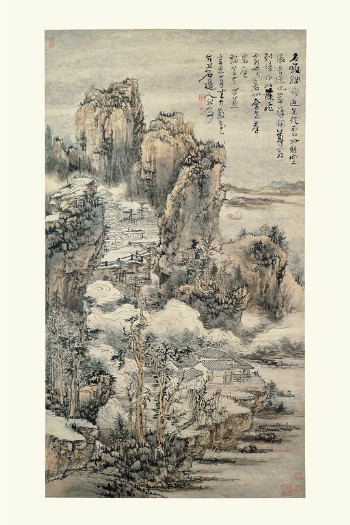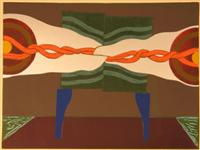Coming Attractions at Museums: February 2010
By Peter Walsh

Luis Meléndez's Still Life with a Piece of Salmon, a Lemon and Kitchen Utensils
Luis Meléndez: Master of the Spanish Still Life, Museum of Fine Arts, Boston, MA through May 9.
Locked into a low-status, unprofitable niche, talented Spanish still-life painter Luis Meléndez (1716–1780) made little money and achieved even less fame during his lifetime. He is said to have complained to the king, who never honored him with a commission, that he owned only his pencils. He is still little known outside his native country. Yet he is now recognized as one of the greatest Spanish still-life painters.
Meléndez mostly ignored the flashier, virtuoso still lifes of the 17th-century Dutch and painted in a quiet, almost contemplative style. His work looks back to the much-admired still-life passages in Velazquez’s figure paintings. It will also remind many of Chardin, a far more successful Frenchman who was about a generation older.
Like Chardin, Meléndez gives unremarkable kitchen assemblages of fruits, pottery, fish, and cooking pots, apparently caught in mid-preparation, a monumental grandeur and dignity, lovingly recording their textures and surfaces. But Meléndez adds a distinctly Spanish touch of mystery, strong contours, and an edgy presence that anticipates 20th-century modernists like Morandi and Picasso. He should appeal more to contemporary tastes in Boston than he did to those of his own time and place.
Rockefeller Treasures at Boston College
Asian Journeys: Collecting Art in Post-war America, Boston College, McMullen Museum, through June 6.

Kuncan (Chinese, 1612–ca. 1686) Temple on a Mountain Ledge China Qing period (1644–1911), dated 1661 Hanging scroll; ink and color on paper Asia Society, New York: Mr. and Mrs. John D. Rockefeller 3rd Collection, 1979.124
A bit further down the list in fame is New York’s Asia Society, founded by John D. Rockefeller 3rd and his wife Blanchette. Asian Journeys, a selection of the important art work they donated to the Asia Society Gallery, opens this month.
Since Boston’s museums collectively own Asian art unmatched — in depth, breadth, and quality — anywhere on planet earth, this is somewhat of a Coals-to-Newcastle show. Asian Journeys compensates a bit by making the exhibition about 20th-century art collecting, JDR 3rd’s advisor, Sherman Lee, a leading American scholar of Asian art and long-time director of the Cleveland Museum, and the power of art to bridge gaps between nations.
Set Piece
Andrea Fraser: Boxed Set, Carpenter Center for the Visual Arts, Harvard University, Cambridge, MA, Feb. 11 through April 4.
Andrea Fraser’s work represents the conjunction of two late-20th-century art trends: a move toward video as a primary medium and the growth of a “bite-the-hand-that-feeds-it” critique of institutional behavior in general and the pomposity of contemporary art institutions in particular. In one especially caustic piece, Fraser, playing museum tour guide, led a bewildered group past an ordinary water fountain in the Philadelphia Museum of Art and proclaimed it “a work of astonishing economy and monumentality . . . it boldly contrasts with the severe and highly stylized productions of this form!”
In Boxed Set, Fraser taps into another 20th-century idea exploited by artists like Marcel Duchamp and Joseph Beuys. The exhibition features five video works made between 1989 and 2001, which she packed as a “box set” and offered for purchase in an “unlimited edition.” Since Fraser uses “found language” from annual reports, director’s letters, and other examples of institutional verbiage, the work makes a clever connection to the “found objects” like urinals and children’s sleds that Duchamp and Beuys repackaged in their own sets of “multiples”—both are ways of cashing in on the shock value of their most famous pieces.
Nama-Simic Synthesis at the Boston Athenaeum
PAINTER + POET: George Nama and Charles Simic Calderwood Gallery, Boston Athenaeum, Boston, MA, Feb. 10 through April 10.

George Nama's Monument for Jean Arp, 1971
Poet-artist collaborations of one kind or another have been a fixture of the art world for centuries, reaching a climax of sorts among the French Romantics of the early 19th-century, when Eugene Delacroix made some famous prints inspired by Lord Byron and Shakespeare. Yugoslavian-born Poet Laureate Charles Simic, one of America’s most distinguished writers, and his near-contemporary George Nama, a New York artist and printmaker, have collaborated for years on a latter-day version of the Delacroix-Byron exchange, revealed in an exhibition opening at the Athenaeum this month.
Though his organic shapes often seem based on studies of the human figure, Nama’s work is mostly abstract. So the etchings, gouaches, sculptures, and artists’ books in this show can’t be seen in any way as simple illustrations. Both Nama and Simic have deep roots in surrealism, so look for strong common currents under the surface.
Davis Redux
Something Like Fireworks, A New Installation by Stephen Vitiello, Davis Museum and Cultural Center, Wellesley College, Wellesley, MA, Feb. 24 through June 6.
Wellesley College’s Davis Museum and Culture Center lost its last director in a scandal about a missing Léger painting, long a prize Davis possession. Lisa Fischmann, a former chief curator of the University of Arizona Museum of Art in Tucson, takes over the Davis helm this month. Fischmann will preside over the opening of the sort of show that characterized the museum back in the 1990s: a large, multimedia presentation by sound artist Stephen Vitiello in collaboration with lighting designer Jeremy Choate.
Best known for his evocative use of ambient sounds, including a 1999 piece that recorded the creakings of New York’s World Trade Center in the remnants of Hurricane Floyd, Vitiello connects light and sound in this solo installation, his first in New England, to create what the museum calls “an immersive, synaesthetic experience.”
Tagged: Andrea Fraser, Asian Journeys, Boston, Boston Athenaeum, Boston College, Carpenter Center for the Visual Arts, Charles Simic, Davis Museum and Cultural Center, George Nama, harvard-university, Lisa Fischmann, Luis Meléndez, mcmullen-museum, Museum of Fine Arts, New England, peter-Walsh, Rockefellers, Stephen Vitiello, Visual Arts
